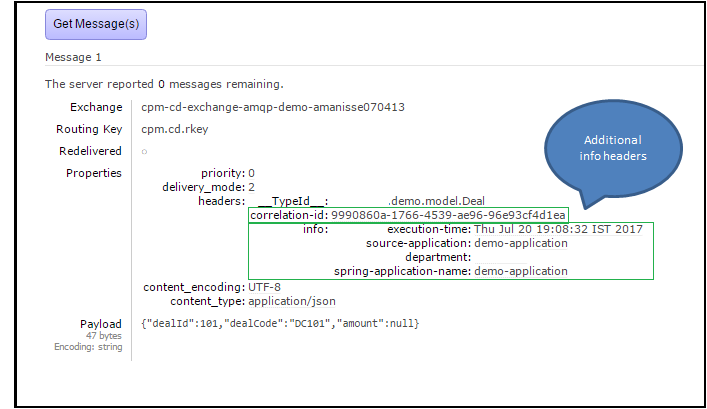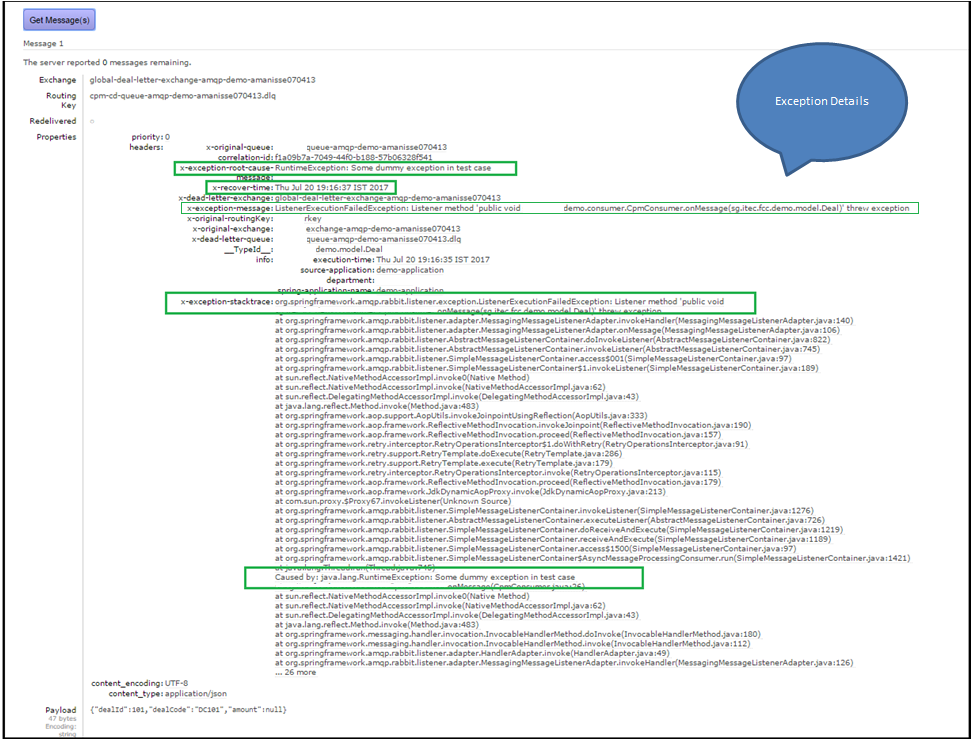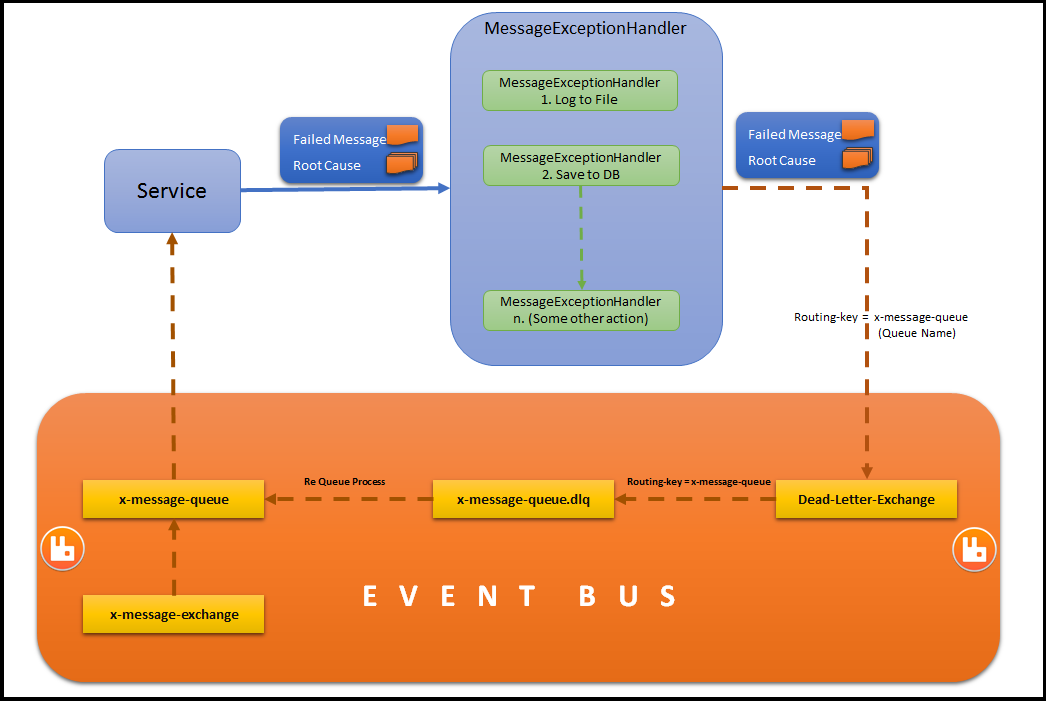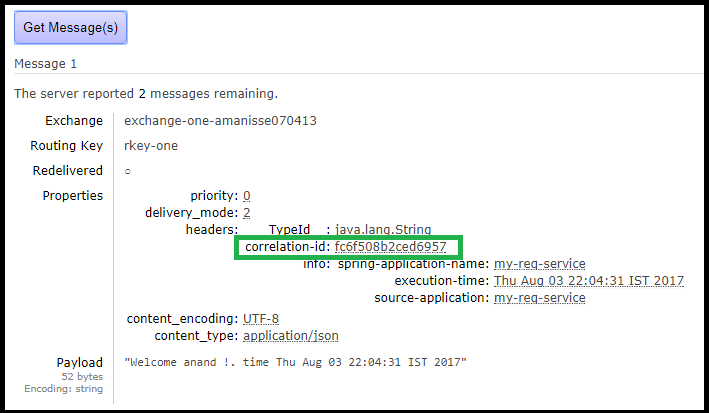rabbitmq-advanced 

A generic library for messaging with RabbitMq, an extension of spring boot amqp.
Note : If you are already using Spring Cloud Stream, you probably don’t need this starter. However, if you need AMQP specific features that are not available through Spring Cloud because of its abstraction level, then you may be interested in it, as it provides features that are available in Spring Cloud. Give it a try, and let us know what you think ! If you see anything that can be improved or simplified, don’t hesitate to propose a change !
Aim
The aim of this project is to provide a generic spring boot starter project for messaging solution with rabbit mq. This helps us to auto configure rabbit mq exchanges and queues along with the binding by simply providing the configurations in yml. This also helps in better exception handling and monitoring at a single place at a framework level. Hence no more duplicate code added for creating exchange and queue with the binding in various projects
Configurations
You can configure rabbit mq server configurations in application.yml under ‘spring.rabbitmq’ section.
You can configure the exchange, queue, binding in application.yml under ‘rabbitmq.auto-config’.
Pom Configuration
Please add below pom dependency for rabbitmq-advanced-spring-boot-starter
<dependency>
<groupId>com.societegenerale</groupId>
<artifactId>rabbitmq-advanced-spring-boot-starter</artifactId>
<version>2.0.0.RELEASE</version>
<!-- check the latest version -->
</dependency>
Spring RabbitMQ Configuration
Below is the sample spring rabbitmq configuration.
spring:
rabbitmq:
addresses: <server>
username: <username>
password: <password>
virtual-host: <v-host>
ssl:
enabled: false
listener:
simple:
default-requeue-rejected: false
retry:
enabled: true
acknowledge-mode: auto
RabbitMQ Auto Configuration
Below is the sample rabbitmq auto configuration.
rabbitmq:
auto-config:
#enable or disable auto configuration. Default is true
enabled: true
#Info Headers can be used to add additional information to be added in each message headers
info-headers:
source-application: ${spring.application.name}
#Exchange configuration at default level, will be applied to all the missing configuration of each Exchange. This can be overridden by configuring at each exchange level.
default-exchange:
type: topic
durable: false
auto-delete: true
#Queue configuration at default level, will be applied to all the missing configuration of each Queue. This can be overridden by configuring at each queue level.
default-queue:
durable: false
auto-delete: true
dead-letter-enabled: true
#Dead Letter Configuration to configure dead letter exchange and queue postfix.
dead-letter-config:
dead-letter-exchange:
name: my-app-dead-letter-exchange-${user.name}
auto-delete: true
durable: false
queue-postfix: .dlq
#Re Queue Configuration to configure the requeue exchange and queue.
re-queue-config:
enabled: true
exchange:
name: re-queue-exchange-${user.name}
queue:
name: re-queue-queue-${user.name}
routing-key: requeue.key
#You can configure all your exchanges here
exchanges:
exchange-one:
name: exchange-one-${user.name}
exchange-two:
name: exchange-two-${user.name}
exchange-mock:
name: exchange-mock-${user.name}
#You can configure all your queue here
queues:
queue-one:
name: queue-one-${user.name}
queue-two:
name: queue-two-${user.name}
queue-mock:
name: queue-mock-${user.name}
dead-letter-enabled: false
#You can configure your bindings for the exchanges and queues here
bindings:
binding-one:
exchange: exchange-one
queue: queue-one
routing-key: rkey-one
binding-two:
exchange: exchange-two
queue: queue-two
routing-key: rkey-two
binding-mock:
exchange: exchange-mock
queue: queue-mock
routing-key: rkey-mock
Info Headers Configuration
You can configure the info headers here. All these header infos will be added to the each message sent by the system.
rabbitmq:
auto-config:
. . .
#Info Headers can be used to add additional information to be added in each message headers
info-headers:
source-application: my-demo-application
department: company/my-department
. . .

Default Exchange Configuration
You can configure the default exchange under this section. All the common properties can be con configured here. At each exchange level you can override the default configuration. All the missing properties will be mapped with default configurations
rabbitmq:
auto-config:
. . .
#Exchange configuration at default level, will be applied to all the missing configuration of each Exchange. This can be overridden by configuring at each exchange level.
default-exchange:
type: topic
durable: false
auto-delete: true
. . .
-
type :
This indicate the type of the exchange.The available parsers are :- topic :
This is for 'topic exchange' and this is the default type. - direct :
This is for 'direct exchange'. - fanout :
This is for 'fanout exchange'. - headers :
This is for 'headers exchange'.
- topic :
-
durable :
This indicate the exchange is durable or not (Boolean) -
auto-delete :
This indicate the exchange auto-delete enable or not (Boolean) -
delayed :
This indicate the exchange delayed enable or not (Boolean) -
internal :
This indicate the exchange internal enable or not (Boolean) -
arguments :
This indicate the exchange arguments to be added (Map)
Default Queue Configuration
You can configure the default queue under this section. All the common properties can be con configured here. At each queue level you can override the default configuration. All the missing properties will be mapped with default configurations
rabbitmq:
auto-config:
. . .
#Queue configuration at default level, will be applied to all the missing configuration of each Queue. This can be overridden by configuring at each queue level.
default-queue:
durable: false
auto-delete: true
dead-letter-enabled: true
. . .
-
durable :
This indicate the queue is durable or not (Boolean) -
auto-delete :
This indicate the queue auto-delete enable or not (Boolean) -
dead-letter-enabled :
This indicate whether dead-letter-queue need to auto configure or not (Boolean) -
exclusive :
This indicate the queue exclusive enable or not (Boolean) -
arguments :
This indicate the queue arguments to be added (Map)
Dead Letter Configuration
You can configure the dead letter exchange and queue postfix. Then all you have to do is for queue , enable the dead letter queue. The dead letter queue will be created with the same name as original queue with dead letter queue postfix. Queue : my-process-queue Dead Letter Queue : my-process-queue.dlq
rabbitmq:
auto-config:
. . .
#Dead Letter Configuration to configure dead letter exchange and queue postfix.
dead-letter-config:
dead-letter-exchange:
name: my-app-dead-letter-exchange-amqp-test-${user.name}
auto-delete: true
durable: false
queue-postfix: .dlq
. . .
rabbitmq:
auto-config:
. . .
queues:
queue-one:
name: queue-one
dead-letter-enabled: false
. . .
-
type :
This indicate the type of the dead letter exchange.
The available parsers are :- topic :
This is for 'topic exchange' and this is the default type. - direct :
This is for 'direct exchange'. - fanout :
This is for 'fanout exchange'. - headers :
This is for 'headers exchange'.
- topic :
-
name :
This indicate the 'Name' of the dead letter exchange. -
durable :
This indicate the dead letter exchange is durable or not (Boolean) -
auto-delete :
This indicate the dead letter exchange auto-delete enable or not (Boolean) -
delayed :
This indicate the dead letter exchange delayed enable or not (Boolean) -
internal :
This indicate the dead letter exchange internal enable or not (Boolean) -
arguments :
This indicate the dead letter exchange arguments to be added (Map)
ReQueue Configuration
You can configure the requeue exchange and queue here. To requeue some message from any dead letter queue, you just have to push a requeue message to requeue exchange with requeue routing key.
rabbitmq:
auto-config:
. . .
#Re Queue Configuration to configure the requeue exchange and queue.
re-queue-config:
enabled: true
exchange:
name: re-queue-exchange-${user.name}
queue:
name: re-queue-queue-${user.name}
routing-key: requeue.key
. . .
-
enabled :
This is to enable or disable requeue -
exchange :
This indicate the 'exchange' configuration for requeue -
queue :
This indicate the 'queue' configuration for requeue -
routing-key :
This indicate the 'routing-key' configuration for requeue
Below is the format for requeue message which requeue 3 message from ‘some-queue.dlq’ to ‘some-queue’
{
"deadLetterQueue" : "some-queue.dlq",
"messageCount" : 3
}
Exchange Configuration
You can configure all the exchanges under this section. (Map)
rabbitmq:
auto-config:
. . .
#You can configure all your exchanges here
exchanges:
exchange-one:
name: exchange-one-${user.name}
exchange-two:
name: exchange-two-${user.name}
exchange-mock:
name: exchange-mock-${user.name}
. . .
-
type :
This indicate the type of the exchange.
The available parsers are :- topic :
This is for 'topic exchange' and this is the default type. - direct :
This is for 'direct exchange'. - fanout :
This is for 'fanout exchange'. - headers :
This is for 'headers exchange'.
- topic :
-
name :
This indicate the 'Name' of the exchange. -
durable :
This indicate the exchange is durable or not (Boolean) -
auto-delete :
This indicate the exchange auto-delete enable or not (Boolean) -
delayed :
This indicate the exchange delayed enable or not (Boolean) -
internal :
This indicate the exchange internal enable or not (Boolean) -
arguments :
This indicate the exchange arguments to be added (Map)
Queue Configuration
You can configure all the queues under this section. (Map)
rabbitmq:
auto-config:
. . .
#You can configure all your queue here
queues:
queue-one:
name: queue-one-${user.name}
queue-two:
name: queue-two-${user.name}
queue-mock:
name: queue-mock-${user.name}
dead-letter-enabled: false
. . .
-
name :
This indicate the 'Name' of the queue. -
durable :
This indicate the queue is durable or not (Boolean) -
auto-delete :
This indicate the queue auto-delete enable or not (Boolean) -
dead-letter-enabled :
This indicate whether dead-letter-queue need to auto configure or not (Boolean) -
exclusive :
This indicate the queue exclusive enable or not (Boolean) -
arguments :
This indicate the queue arguments to be added (Map)
Binding Configuration
You can configure all the bindings under this section. (Map)
rabbitmq:
auto-config:
. . .
#You can configure your bindings for the exchanges and queues here
bindings:
binding-one:
exchange: exchange-one
queue: queue-one
routing-key: rkey-one
binding-two:
exchange: exchange-two
queue: queue-two
routing-key: rkey-two
binding-mock:
exchange: exchange-mock
queue: queue-mock
routing-key: rkey-mock
. . .
-
exchange :
This indicate the exchange key which you want to bind with the given queue. -
queue :
This indicate the queue key which you want to bind with the given exchange. -
routing-key :
This indicate the routing-key used to bind the given exchange and queue -
arguments :
This indicate the arguments to be added for the binding (Map)
Exception Handling
Enable Dead Letter Queue
You can enable dead letter queue for each queue by providing below configuration in respective queue configuration or at the default queue configuration
rabbitmq:
auto-config:
. . .
#Dead Letter Configuration to configure dead letter exchange and queue postfix.
dead-letter-config:
dead-letter-exchange:
name: my-app-dead-letter-exchange-amqp-test-${user.name}
auto-delete: true
durable: false
queue-postfix: .dlq
. . .
queues:
some-queue:
...
dead-letter-enabled: true #Enable Dead Letter Queue at individual queue level
...
. . .
With the above configuration , the failed message will be sent to the dead letter queue which is bind to the dead letter exchange as per the configuration. Example : If the queue name is ‘some.dummy.queue’ and dead-letter-queue-postfix is ‘.dlq’ then dead letter queue will be ‘some.dummy.queue.dlq’

The above is the sample message in the dead letter queue.
Message Exception Handler
In addition to the above dead letter queue, we can also configure MessageExceptionHandler to have additional exception handling like saving the failed message exception to database, or doing additional logging etc.
If you want to handle MessageException, you can implement the MessageExceptionHandler and configure the bean in Spring.
Each message and the exception will be passed to all MessageExceptionHandler (if its configured)
You need to enable the retry to use the message exception handler
spring:
rabbitmq:
...
...
listener:
default-requeue-rejected: false
retry:
enabled: true

public interface MessageExceptionHandler {
void handle(Message message, Throwable cause);
}
@Slf4j
public class LogMessageExceptionHandler implements MessageExceptionHandler {
@Override
public void handle(Message message, Throwable cause) {
Map<String, Object> headers = message.getMessageProperties().getHeaders();
log.warn("Dead letter message from queue , message , headers : cause",
headers.get("x-original-queue"), getMessageString(message), headers, cause);
}
protected String getMessageString(Message message) {
String contentType = message.getMessageProperties() != null?message.getMessageProperties().getContentType():null;
if("text/plain".equals(contentType) || "application/json".equals(contentType) || "text/x-json".equals(contentType) || "application/xml".equals(contentType)) {
return new String(message.getBody());
}
else {
return Arrays.toString(message.getBody()) + "(byte[" + message.getBody().length + "])";
}
}
}
@Configuration
public class ConfigClass {
//...
@Bean
@Order(1)
public MessageExceptionHandler logMessageExceptionHandler() {
return new LogMessageExceptionHandler();
}
//...
}
Correlation Id
The correlation id will be added to the message automatically as part of tracer.


Contributions
Main author of the project is Anand Manissery. For any question or suggestion please initiate a discussion through the project issues.
Pull requests are welcome. We follow a strict test driven approach, so make sure your contribution is well tested.
Thanks and acknowledgement
- Vincent FUCHS
- Patrice FRICARD
- Igor LOVICH
- Rahul DAS
Thanks a lot for your inputs and feedback that have made the v1.0.0 possible !
License
License is under the Apache V2 License.
See LICENSE.md or Apache License